  Warthogs are sturdy animals weighing up to 23 kilograms, and distinguished by large heads and 'warts' - thick protective pads on both sides of the head. Two higher tusks curve upward from the sides of the snout, and a lower set are worn to a sharp cutting edge. Bristles cover their body, longer ones forming a mane from the top of the head to the middle of the back. Their long tail ends with a tuft of bristles. Warthogs usually carry their tails upright when they run.
Warthogs are sturdy animals weighing up to 23 kilograms, and distinguished by large heads and 'warts' - thick protective pads on both sides of the head. Two higher tusks curve upward from the sides of the snout, and a lower set are worn to a sharp cutting edge. Bristles cover their body, longer ones forming a mane from the top of the head to the middle of the back. Their long tail ends with a tuft of bristles. Warthogs usually carry their tails upright when they run.Warthogs can live up to 18 years in the wild, and despite being able to run at speeds up to 55 km/h, often fall prey to lions, leopards, hyenas and crocodiles. 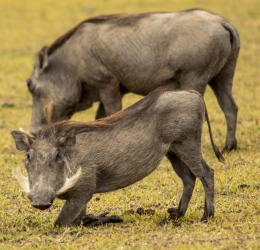 Razor-sharp lower tusks help defend against predators, as well as to dig up food and water. Warthogs have poor eyesight, but an excellent sense of smell, which is used to hunt for food and to detect enemies. Warthogs appear ferocious, but they are grazers, eating grasses and plants. They use their snouts to dig up roots, and also eat short grasses, seeds, roots, fruit, and occasionally carrion. They can often be seen kneeling on their calloused, padded knees to eat short grass. They will also consume soil and bones for minerals and trace elements, and dung of other animals for the nitrogen content. Warthogs are able to go long periods without water.
Razor-sharp lower tusks help defend against predators, as well as to dig up food and water. Warthogs have poor eyesight, but an excellent sense of smell, which is used to hunt for food and to detect enemies. Warthogs appear ferocious, but they are grazers, eating grasses and plants. They use their snouts to dig up roots, and also eat short grasses, seeds, roots, fruit, and occasionally carrion. They can often be seen kneeling on their calloused, padded knees to eat short grass. They will also consume soil and bones for minerals and trace elements, and dung of other animals for the nitrogen content. Warthogs are able to go long periods without water.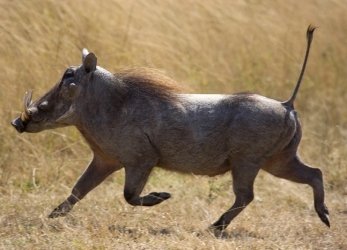 The warts on their face are skin growths without underlying bone, and grow larger with age. They protect the eyes during fights with rivals. Otherwise a warthog usually avoids danger by running away. The raised tail with a tuft at the end is a danger warning to others.
The warts on their face are skin growths without underlying bone, and grow larger with age. They protect the eyes during fights with rivals. Otherwise a warthog usually avoids danger by running away. The raised tail with a tuft at the end is a danger warning to others. However, when cornered by a predator, a warthog will defend itself, and can inflict severe wounds with its tusks, particularly the lower sharp ones. 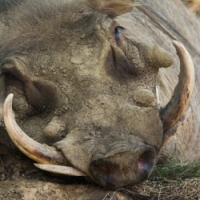 Although they can excavate, warthogs normally use holes dug by other animals, where they rest or sleep. The holes also provide a way for the warthog to regulate its temperature; with neither fur nor fat, it lacks protection from the sun and insulation from the cold at night. Sometimes they will fill the holes with grass for warmth.
Although they can excavate, warthogs normally use holes dug by other animals, where they rest or sleep. The holes also provide a way for the warthog to regulate its temperature; with neither fur nor fat, it lacks protection from the sun and insulation from the cold at night. Sometimes they will fill the holes with grass for warmth. Warthogs also seek relief from the heat by wallowing in mud. As well, this serves as camouflage, and as protection from biting insects. 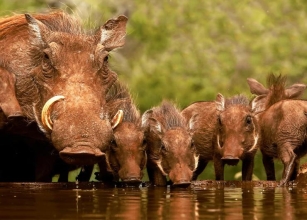 Warthogs live in family groups composed of one or more females and their young. Males normally live alone, only joining a group to mate. Before giving birth to a new litter, the female will chase away the litter she has been raising. The female suckles the new litter, and each piglet has its own teat, suckling exclusively from it. Even if a piglet dies, the others do not suckle from the available teat. Litter sizes are usually confined to four young because females only have four teats.
Warthogs live in family groups composed of one or more females and their young. Males normally live alone, only joining a group to mate. Before giving birth to a new litter, the female will chase away the litter she has been raising. The female suckles the new litter, and each piglet has its own teat, suckling exclusively from it. Even if a piglet dies, the others do not suckle from the available teat. Litter sizes are usually confined to four young because females only have four teats. 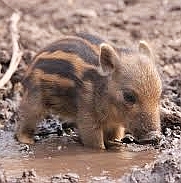 Interactions between members of a group are friendly. Social grooming is common, and at night and in the midday heat they lie in a den, which may be a cave, a hollow under a rock, or an abandoned burrow where the temperature remains constant. The young enter first, followed by the adults, who enter backwards in order to defend the entrance with their tusks. Dens are very clean; members of the group will drop their dung together in one place. This habit may be to confuse predators as to the number of individuals.
Interactions between members of a group are friendly. Social grooming is common, and at night and in the midday heat they lie in a den, which may be a cave, a hollow under a rock, or an abandoned burrow where the temperature remains constant. The young enter first, followed by the adults, who enter backwards in order to defend the entrance with their tusks. Dens are very clean; members of the group will drop their dung together in one place. This habit may be to confuse predators as to the number of individuals. Female warthogs communicate with grunts, chirps, growls, snorts, and squeals. The sounds can be greetings, or threats and warnings when they are nervous. Hear the sound of a tense warthog: |